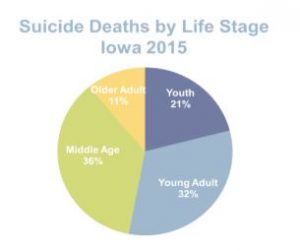A new state-based surveillance system is helping Iowa learn more about the circumstances surrounding violent deaths such as suicide.
Iowa released its first report from the Iowa Violent Death Reporting System (IAVDRS), which tracks trends overtime and provides a complete picture – the who, when, where and how of violent deaths. Data from death certificates, medical examiner reports and law enforcement reports are linked together to help state and local practitioners understand the deeper contexts of violent deaths.
The report highlights results from 2015, the year Iowa began using the system, and comprises Iowa’s seven most populous counties, including: Black Hawk, Johnson, Linn, Pottawattamie, Polk, Scott, and Woodbury. Nearly 75% of violent deaths were from suicide (174 deaths), followed by homicide (18%), undetermined (6%), legal intervention (1%) and unintentional firearm (less than 1%).
The most frequently cited circumstances surrounding suicide in Iowa for all ages were depressed mood (83%), mental health problem (54%), history of mental illness treatment (42%) and history of suicidal thoughts (37%).
Iowa’s suicide rate increased by 9% from 2014 to 2015 and is slightly higher than the national average.
The report, Suicide in Iowa, 2015: Iowa Violent Death Reporting System Special Report, is a joint effort by the Iowa Department of Public Health (IDPH) and the UI IPRC.
 IAVDRS Program Director Binnie LeHew of the IDPH said she anticipates IAVDRS data will be of interest to local law enforcement, community service providers and public health partners interested in developing strategies to prevent violent deaths.
IAVDRS Program Director Binnie LeHew of the IDPH said she anticipates IAVDRS data will be of interest to local law enforcement, community service providers and public health partners interested in developing strategies to prevent violent deaths.
“It is a valuable resource because it combines information from three data sources to give us a deeper context for understanding violent deaths,” she said.
More youth aged 10-24 (43%) disclosed their intent to another person prior to the suicide compared to young adults (25%) and middle-aged groups (20%), while older adults were least likely to disclose intent. More older adults (47%) left a suicide note compared to youth (30%), and more youth and young adults had intimate partner problems that contributed to the circumstances than the older groups.
IDPH Suicide Prevention Coordinator Pat McGovern said this first IAVDRS report reminds us that suicide is a complex problem and prevention strategies may vary for different populations.
“For example, since teens are more likely to tell someone they are thinking of self-harm, we want to be sure that their peers and supportive adults in their lives know what to do and where to turn for help if a teenager is at risk for suicide,” he said.
Suicide affects all Iowans, regardless of age, race and gender. Middle-aged people (aged 45- 64) made up the largest proportion of suicide deaths at 35%. Young adults (aged 25-44) comprised 33% of deaths and youth (aged 10-24) comprised 23%. Older adults 65 years and older made up 9% of all suicide deaths. For all suicides, more than twice as many males died than females.
 Asphyxiation was the manner of death in 43% of suicides, followed by firearm use (34%) and poisoning (19%).
Asphyxiation was the manner of death in 43% of suicides, followed by firearm use (34%) and poisoning (19%).
LeHew said, “Each year, Iowa will complete data collection on violent deaths that occurred in the prior year and a half – for example, data from deaths that occurred in 2016 will be available after summer 2018, and so on. Timeliness and completeness of the data are important goals of the system.”
Iowa is one of 42 states funded by the Center for Disease Control and Prevention (CDC) to collect data on violent deaths for the National Violent Death Reporting System (NVDRS) and enter the data into a national database. Researchers and practitioners can access the NVDRS online database to get more comprehensive details surrounding violent deaths.
*note: all Iowa counties will be included in the 2016 IAVDRS data.
Published 11/2017


